When you think of Greek islands, do you picture typical white houses with blue shutters? It’s time to abandon that stereotype and discover the green, slightly less obvious side of Greece.
Corfu is the northernmost island in the Ionian Sea. It is constantly referred to as the greenest of all the Greek islands, and it’s this lush landscape that sets it apart from the popular islands of the Aegean Sea.
It is the second most populous island in Greece. However, it’s not only loved by the Greeks but also by the throngs of tourists who visit each year. They are captivated by Corfu’s geography, dominated by olive tree-covered mountains, a coastline rich in small and large bays, and architecture inspired by the Venetian style.
Corfu in Mythology
For some, Corfu is known from personal experience, for others from geography lessons, and still others from mythology. Corfu, called Kerkira or Kerkyra by the Greeks, owes its name to the nymph Kercira, with whom Zeus fell madly in love. The greatest of the ancient Greek gods abducted the nymph and brought her to the island we now know as Corfu. Mythology also describes the island’s stunning nature and the hospitality of its inhabitants, but the most famous story associated with Corfu is undoubtedly that of Odysseus’ legendary journey. This slice of Hellas is believed to be the mythical island where the hero from Ithaca was cast ashore during his journey home.
The Capital of Corfu
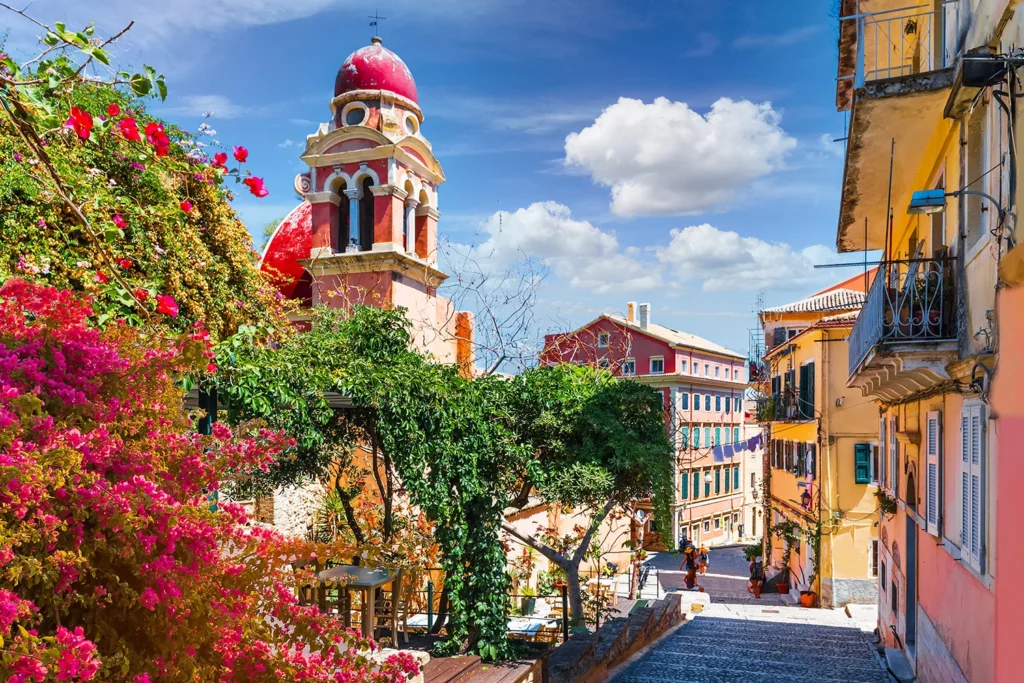
The island’s capital, known to tourists as Corfu Town or Kerkyra, is located just 2 km from Corfu Airport, so you can easily walk from the plane to the city center. However, it’s worth noting that even more walking likely awaits you once you arrive. After all, strolling through the narrow, picturesque streets of the old town is the best way to immerse yourself in the atmosphere of this UNESCO World Heritage-listed city.
Corfu Town is situated in the central part of the island. It has been inhabited since ancient times, and its long history is evident in its streets lined with medieval buildings, castle ruins, and districts filled with old Venetian-style houses. As you explore the city, it’s hard to ignore the charming squares or the tantalizing aromas from local restaurants, but don’t forget to visit the old district of Campiello, Mon Repos Palace, and a few other key sites that deserve special mention.
Spianada
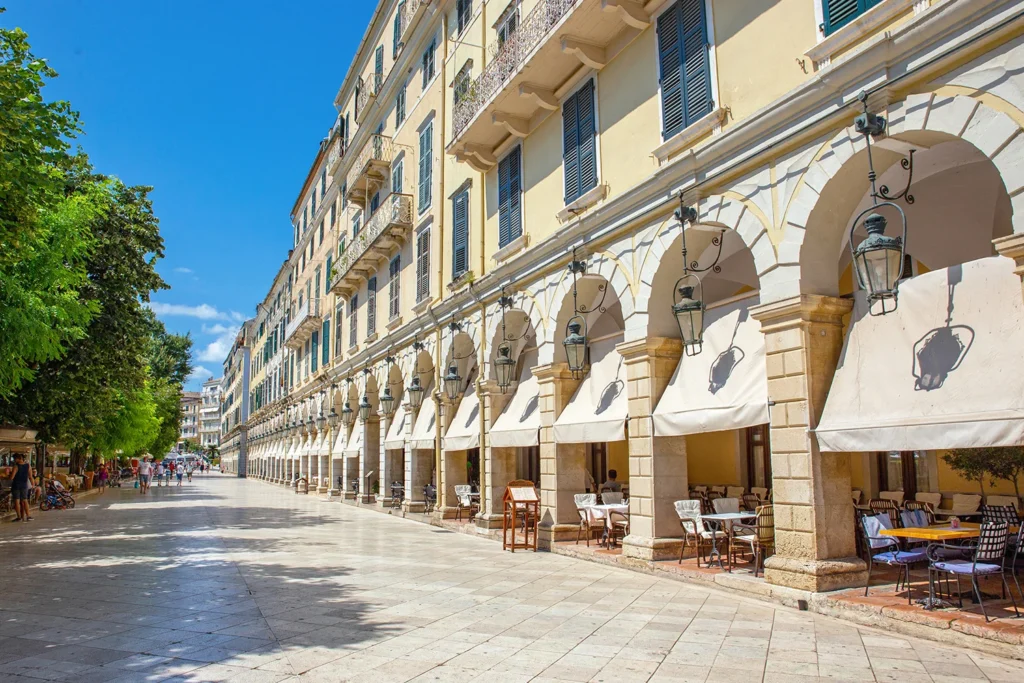
The central square of Corfu Town is called Spianada. It’s the most common meeting place for locals and the main venue for many of the capital’s events. Right next to it lies the beloved Liston, a promenade offering a wide selection of cafes and taverns eager to satisfy the palates of their guests. Interestingly, Spianada plays a special role not only in the life of the island’s capital but also for the entire country, as it’s considered the largest square in all the Balkans.
The Two Fortresses of Corfu Town
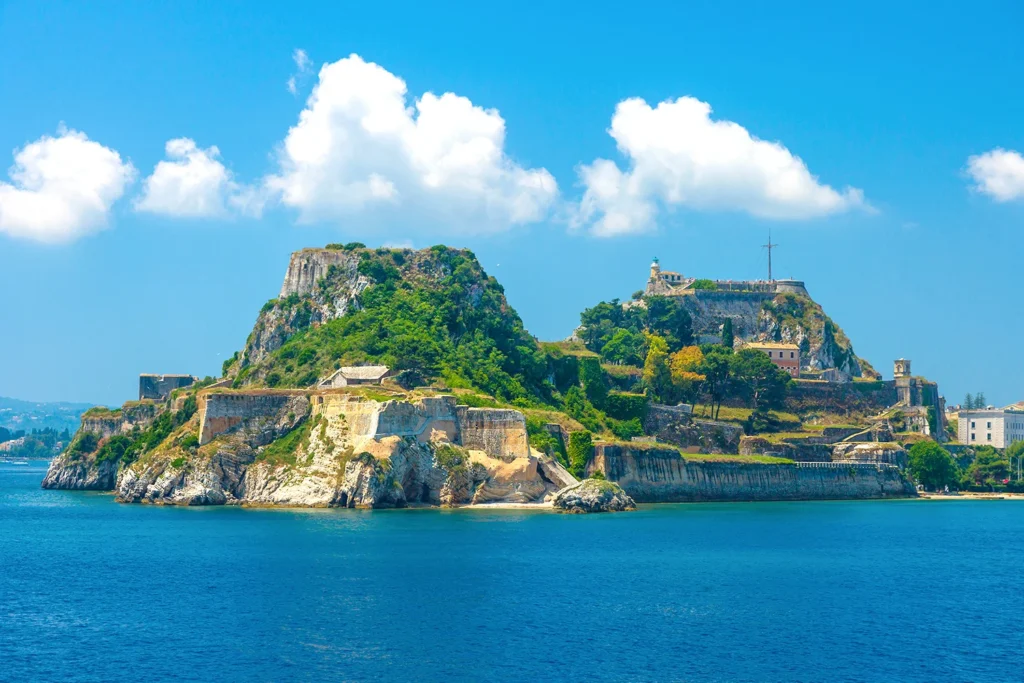
If you’re looking to check off all the must-see landmarks of Corfu Town, you can’t miss the two fortresses guarding the city. The Old Fortress is situated on a rocky peninsula jutting into the sea on the eastern side of the city. Once, it protected the capital from pirate invasions, and today it stands as one of the most recognizable landmarks on the island. The New Fortress, built by the Venetians, is a popular point of reference during city tours, as the structure can be seen from the moment you set foot on Corfu.
Museum of Asian Art
Corfu offers something for everyone, whether you’re a beach lover or someone who enjoys spending their free time uncovering new curiosities. And nothing provides such a wealth of information as local museums. The most unique one on Corfu is the Museum of Asian Art, which for a very modest price, showcases exhibits of Chinese porcelain, stunning Japanese paintings, and figurines from India and Korea. Just imagine – this could be a one-of-a-kind opportunity to experience the diversity of Asian art and culture right in the heart of Greece.
Other Museums in the Capital of Corfu
Between the Old Port and the Old Fortress of Corfu lies a 14th-century church that even those who usually skip church stops should visit. This is because the building houses the Byzantine Museum, a treasure trove of ancient paintings, precious silver objects, embroidered garments, and ornate jewelry.
However, art isn’t the only thing on display in Corfu’s museum halls. If you’re drawn to history, you might be interested in the Archaeological Museum, whose star attraction is the western pediment of the Temple of Artemis. Another option is the Banknote Museum of Alpha Bank, which showcases an extensive collection of banknotes, printing plates, and detailed illustrations of the stages in the modern money-making process.
Near the City of Corfu
After spending long days in the capital, it’s worth leaving the city for a while to explore the charms of other nearby tourist spots.
Vlacherna Monastery
One such place near the city of Corfu is the Kanoni peninsula, home to the sacred Vlacherna Monastery, adorned with mosaics, ornaments, and a beautifully carved wooden iconostasis. What makes this monastery stand out even more is its exterior appearance and location—it’s a striking white speck on a tiny islet, connected to the mainland by a narrow path. And surprisingly, seeing this church from a bird’s-eye view is quite easy, as the island’s airport runway, where planes arrive, is located right next to it.

DID YOU KNOW? From the peninsula where the monastery sits, boats depart to take visitors to Mouse Island (Pontikonisi), visible on the horizon. Don’t worry, there are no mice living there. The island’s name refers to its small size, as it is tiny. However, it’s a popular spot among tourists, primarily because it was once a favorite destination of Empress Sissi.
Danilia Village
Just 10 km northwest of the city of Corfu lies Danilia Village, which can be compared to an open-air museum. It’s an exceptional replica of a traditional Corfiot village, allowing visitors to delve into the island’s history. This colorful settlement, nestled in Corfu’s greenery, not only showcases the island’s typical architecture but also its cuisine, offering the chance to taste the finest dishes of traditional Greek food.
Achilleion Palace
10 km southwest of the city of Corfu, on a hill bathed in lush greenery, stands an extraordinary palace. This neoclassical palace features grand halls adorned with marble sculptures and mosaics at every corner. As you stroll through its interiors, you’ll be captivated by the iconic statue of Achilles and the Imperial Throne, crafted especially for Emperor Franz Joseph I of Austria. Surrounding the building, more surprises await. Be sure to visit the terrace, offering stunning views of the Ionian Sea, and the truly royal gardens.
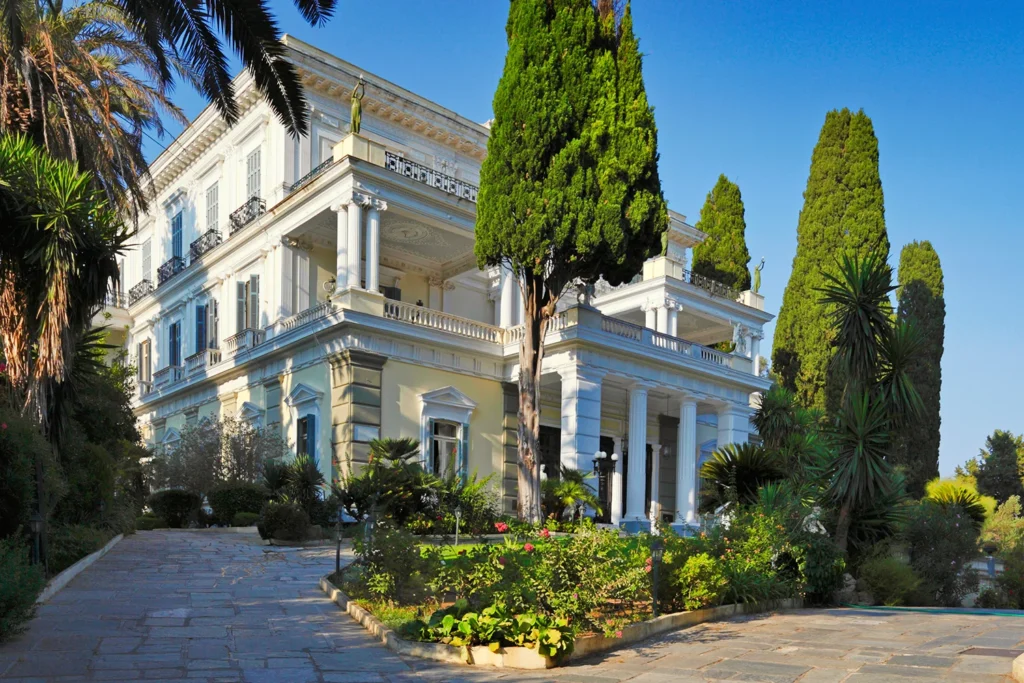
Visitors to the Achilleion Palace often fall into two categories—those who come for the sheer beauty of the residence and its enchanting surroundings, and those fascinated by its remarkable history. After all, not everyone knows that this iconic palace was built by Empress Elisabeth of Austria, known as Empress Sisi. Additionally, there’s yet another group of tourists and locals who flock to the palace for entirely different reasons. They come to attend the many concerts, festivals, exhibitions, and theatrical performances that are regularly hosted here.
Kassiopi

Although Kassiopi is considered by many to be the second most popular town on Corfu, it has only about 1,000 residents. Tourists often visit, mainly due to the newly built peaceful apartments and luxurious hotels, but despite this, the town remains free of overwhelming crowds, allowing for easy navigation through its narrow streets. Located in the northeastern part of Corfu, the town offers stunning views of the Albanian coast, just 2 km away from its beaches.
The town developed around the Church of the Virgin Mary Kassopitra, which likely occupies the site of an earlier sanctuary dedicated to Zeus Kassios. Kassiopi thrived during Roman and Byzantine times. Later, it was gradually abandoned by its inhabitants, though the church never ceased functioning. However, the church is no longer the heart of the town, as the waterfront has taken on that role, regularly attracting both locals and tourists alike.
Monastery of Mirtiotissa
If you value serene tranquility over tourist crowds during your vacations, the Monastery of Mirtiotissa, located in the western part of the island, will likely enchant you. This destination sees relatively few visitors, allowing the resident monk to easily fulfill his main purpose: providing pilgrims with a sense of peace and harmony that will stay with them long after leaving this place.
However, the monastery is worth visiting not only for its tranquility. Another draw for tourists is the surrounding panorama. The building is encircled by towering pine trees and lush olive groves. On one side, you’ll be captivated by the stunning mountain views, while on the other, you’ll gaze upon the azure sea. The monastery building itself is a sight to behold, as despite being over 400 years old, it appears remarkably untouched by time.
Angelokastro – Castle of Angels
On the edge of the western part of Corfu, perched atop a high, rocky hill, stands one of the most important and oldest Byzantine castles in Greece. Angelokastro, or the Castle of Angels, takes its name… well, the exact origin is unclear. Historians suspect, however, that the castle’s creator, Michael II Komnenos Doukas, named the structure in honor of his father, known as Michael Angelos.
The castle stands 305 meters above sea level, making it an ideal spot to observe not only the sea stretching out below but also the city of Corfu and even the mountains of mainland Greece. However, once you pass through the domed gate, you’ll find more than just breathtaking views. Inside are storage rooms with invaluable artifacts and an ancient church built in a cave, dedicated to the two angels, Gabriel and Michael.
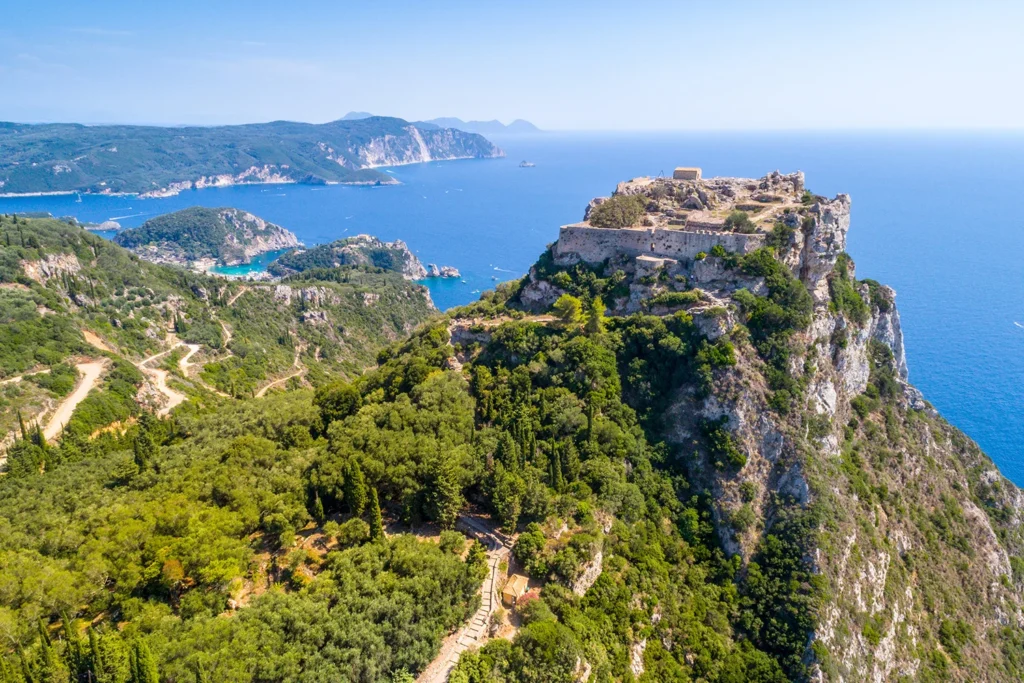
Not Just One Agios Georgios
On Corfu’s western coast, you’ll find two villages that share the same name. The southern Agios Georgios is a small, quiet, and minimally touristic village. It’s the perfect place for peaceful strolls, sunbathing, or visiting the picturesque Korisia Lake, located just a bit farther south.
Meanwhile, Agios Georgios is also the name of a small resort located in the northern part of Corfu. This village is another paradise for those seeking quiet relaxation. Tourism hasn’t spoiled the natural beauty of the Greek landscape here, and so far, it hasn’t affected the warm hospitality of the local residents. It’s an ideal place to experience a touch of authentic Greece. While the area may not thrill you with lively parties, the rolling landscape of fields, olive groves, and wooded hills will surely touch your heart.
Cape Drastis

The northernmost point and one of the island’s most iconic spots is Cape Drastis. Once recognized for its strategic importance, today this corner of Corfu is renowned for its natural beauty. The sight of white cliffs curving into the turquoise, choppy waters of the sea, with small, lush islands nearby, is bound to win you over.
If you want to get better acquainted with this place, drive to the small parking area, then follow the sandy path on foot, which leads to three picturesque viewpoints. You can also descend the cliffs to a secluded beach, swim in the shadow of the impressive cliffs, or rent a boat to admire the cape from an entirely different perspective.
The Most Beautiful Beaches of Corfu

If all you need for a perfect vacation is extraordinary beaches made for all-day relaxation, Corfu is an excellent choice. Whether you’re staying in the southern part of the island or up north, stunning beaches are always just around the corner. What kind of beaches? There’s no single way to describe them. The island offers sandy and pebbly shores, beaches with easy access or pristine, more secluded spots that require a bit of effort to reach, as well as hidden green coves and wide, urban beaches stretching for kilometers along the coast.
In the western part of the island, Paleokastritsa Bay reigns supreme, famous not only for its beauty but also for its connection to Odysseus, as many sources suggest that this was where the mythical hero stopped during his journey to Ithaca. Other popular beaches on Corfu include:
- Logas Beach, located at the foot of an impressive, towering cliff.
- Saint George Beach, a beautiful sandy beach.
- Chalikounas Beach, a long and tranquil stretch of sand.
- Sidari Beach, also known as the Canal d’Amour, famous for its unique rock formations.
- Agios Stefanos Beach, offering a relaxing atmosphere.
- Kavos Beach, the island’s party hotspot.
- La Grotta Beach, a rocky cove ideal for a peaceful swim.
Heavenly Porto Timoni

When it comes to Corfu’s beaches, Porto Timoni simply cannot be overlooked, outshining most other beaches in the northern part of the island. It’s arguably one of the most famous beaches in Corfu. This sandy and pebbly shore is located on a peninsula near the village of Afionas. The twin beaches are separated by a narrow strip of land densely covered with lush vegetation. One glance is enough to understand why this spot steals the hearts of all who visit Corfu.
Porto Timoni is a must-see during your stay on Greece’s green island, as long as you’re up for a bit of a hike. To reach this remote and serene place, you’ll need to take a moderately challenging, yet steep and rocky trail through the mountains. However, if peace and untouched nature are what you seek, this trek will definitely be worth it. Along the way, you’ll be treated to stunning views, and once there, you can not only sunbathe and swim in the warm waters of the Ionian Sea, but also enjoy snorkeling or taking a boat ride.
Beaches Not Just for Sunbathers
Long hours lying on the sand bore you? That doesn’t mean you have to give up beach time. At least not on Corfu, because this island is also prepared for adventure lovers and sports enthusiasts. A refreshing change from lounging could be exploring one of the caves near Paleokastritsa – like Blue Eye Cave or Nausika Cave.
Consider the town of Dassia, a favorite spot for water sports fans. Here you can rent kayaks and pedal boats, try paddleboarding, or hop on a boat. If you’re craving a bit more thrill, give waterskiing or parasailing a try.
GOOD TO KNOW: By taking boat trips from Corfu, you can quickly reach mainland Greece, Italy, Albania, and the nearby Greek islands of Paxos and Antipaxos. These last two islands are especially beloved by those who appreciate wild and unconventional landscapes.
Corfu’s Gastronomy – What to Try
Fresh fish, olive oil, honey, and local wine—these are the essentials to look for in traditional shops and Corfiot restaurants. As for specific dishes, you must try lamb, a staple frequently enjoyed by the island’s residents. Also, make sure to try sofrito—veal in a wine-based sauce, pastitsada—a meat casserole with pasta, zorka—a vegetable pie, and if you’re a fan of seafood, the dish bianco.
Kumquat – Gold on the Plate and in the Glass
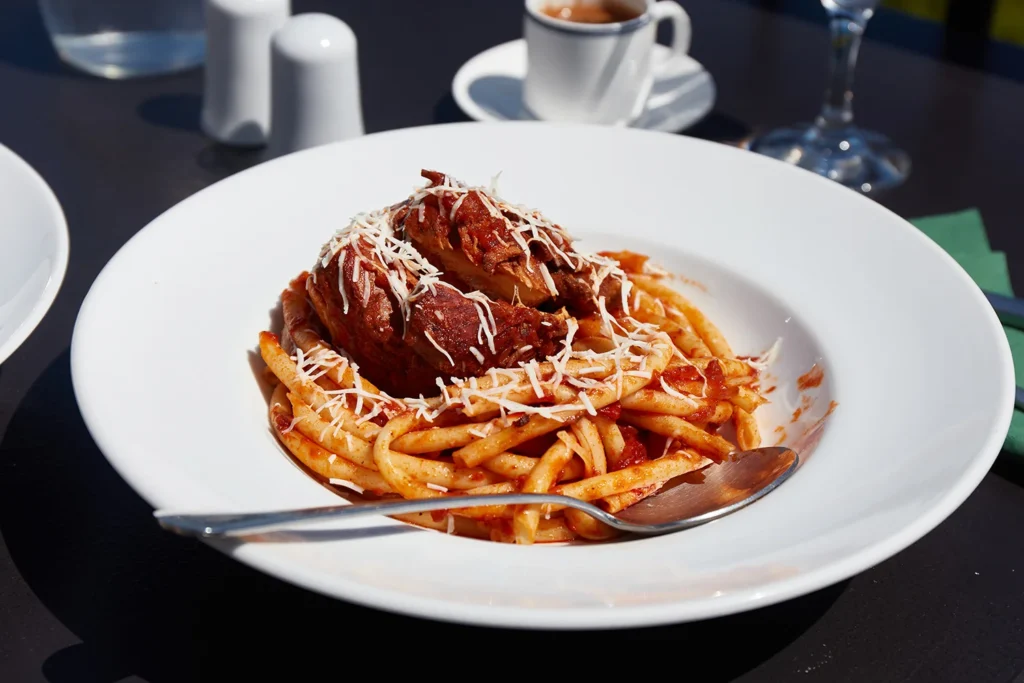
Although kumquat is originally from China, it is now considered a traditional product of Corfu, as this small fruit has been a staple of island gastronomy for decades. It is mainly cultivated in the northern part of Corfu, particularly in the village of Nymfes, known as the center of Greek kumquat production. The sweet and sour fruit is used to make desserts, jams, sweets, and jellies, but most notably, it serves as the base for a popular high-quality liqueur.
Exploring Corfu
The best way to explore Corfu is by renting a car (services like RentalCars can help), as reaching places like Cape Drastis or the Monastery of Mirtiotissas isn’t possible via public transport.
Organized tours with a guide or boat cruises can also help you discover the island, offering the chance to fall in love with Corfu’s diverse coastline. Platforms like GetYourGuide assist in booking such activities, as well as organizing local wine tastings, vineyard tours, and even cooking lessons under the guidance of native Corfiot chefs.